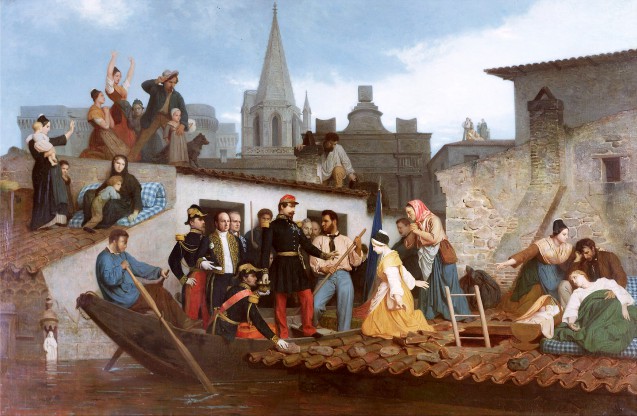Fro, the ancients on, history painting was considered art’s noblest genre. And this opinion held good through the Renaissance right up to the end of the Second Empire. It had become the type of art that we would nowadays call ‘documentary’, though the scenes were often carefully staged. The public demanded modern subjects, often from current affairs, almost newspaper snapshots. At the Salon of 1857, the 440,000 or so visitors expected to be presented with views of recent events, and they were not disappointed. Harrowing pictures of the Crimean War were displayed in one of the principal exhibition halls, followed by views of the dreadful Rhone and Loire floods which had ravaged many regions of France in the spring of 1856.
Praise of the magnanimity and virtues of the sovereign has always been the mission of official art, and under Napoleon III the state ministry acted accordingly, perfectly in tune with the rules of propaganda art, commissioning several artists to provide works celebrating the Emperor’s paternal generosity. William Bouguereau’s contribution was this representation of the emperor visiting the flood victims in Tarascon. Alexandre Antigna painted the emperor’s visit to the slate workers in Angers, and Jean-Raymond-Hyppolite Lazergues chose the distribution of aid to those flooded out in Lyon as his subject. The difference between the First and Second Empires here is striking. Napoleon I was able to call upon the towering geniuses of David, Gros and Ingres, whilst Napoleon III could only mobilise the lesser talents of a group of young, rigidly academic artists. Leaving traditional classicism behind, many had adapted to the requirements of the modern era, shaken as it was by the industrial revolution and new technology. The genre of Realism had begun to appear following on from the Revolution of 1848, and the painting of scenes of pathos taken from the world of work and more generally that of the poor began to appear even in official art, although it never reached the radical heights achieved by painters such as Courbet and Millet.
During the 1857 Salon, another painting, entitled Un trait de jeunesse de Napoléon III (A scene from Napoleon III’s youth) by Lasalle, was displayed. It illustrated an ‘event’ from the young life of Napoleon III whereby he had supposedly returned home half -naked after having given most of his clothes to a poor family. Fostered by this visual propaganda, Second Empire subjects began gradually to accommodate this vision of a sensitive and humane sovereign, the protector of the Nation and of his people, open to social progress.
The flood victims of Tarascon was to be Bouguereau’s only sally into the painting of current affairs. Despite receiving his first medal for his pains, poor reception of the work by critics led him to return to the idealised subjects with which he made his career.
Karine Huguenaud (tr. P.H.)
June 2006


